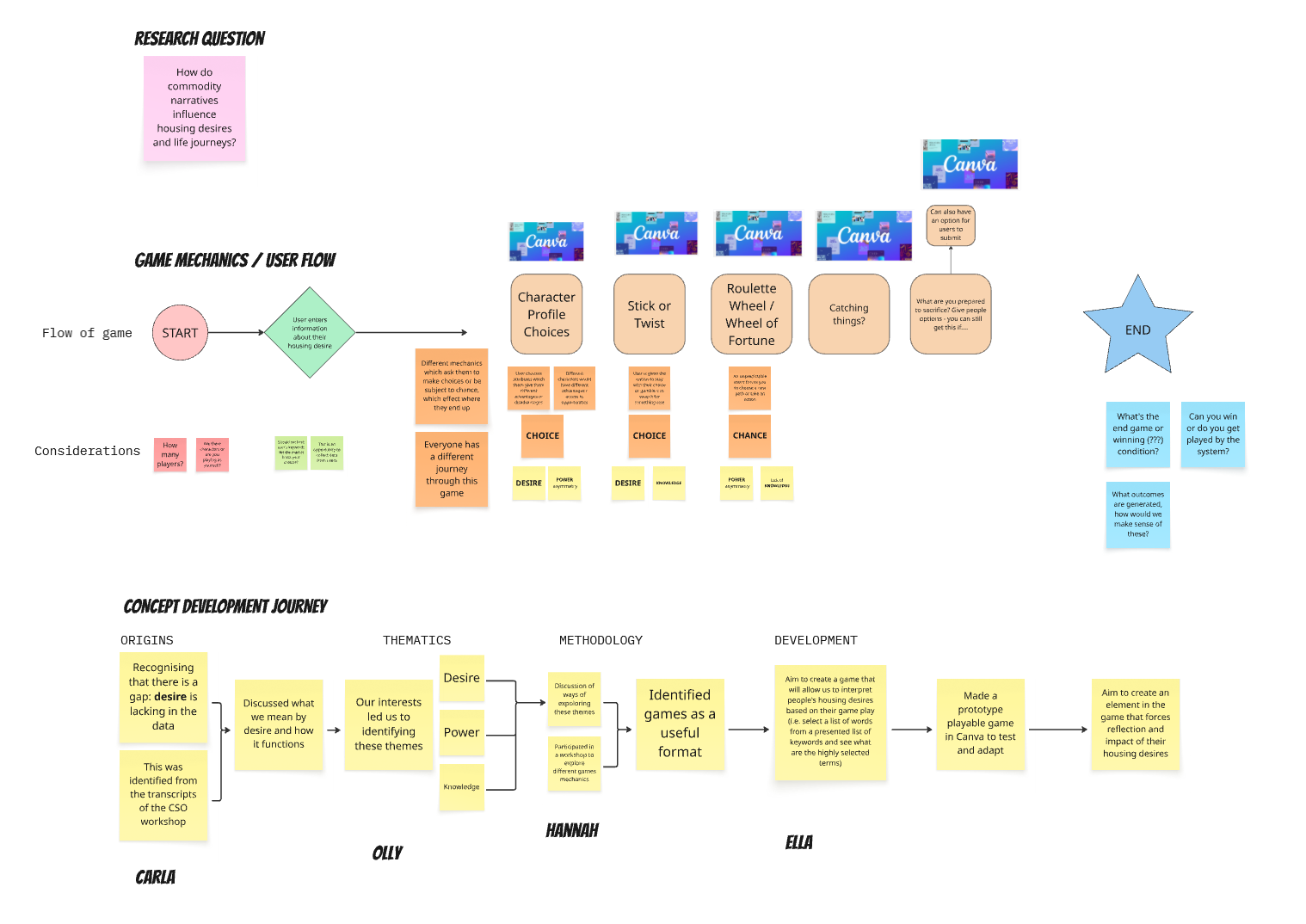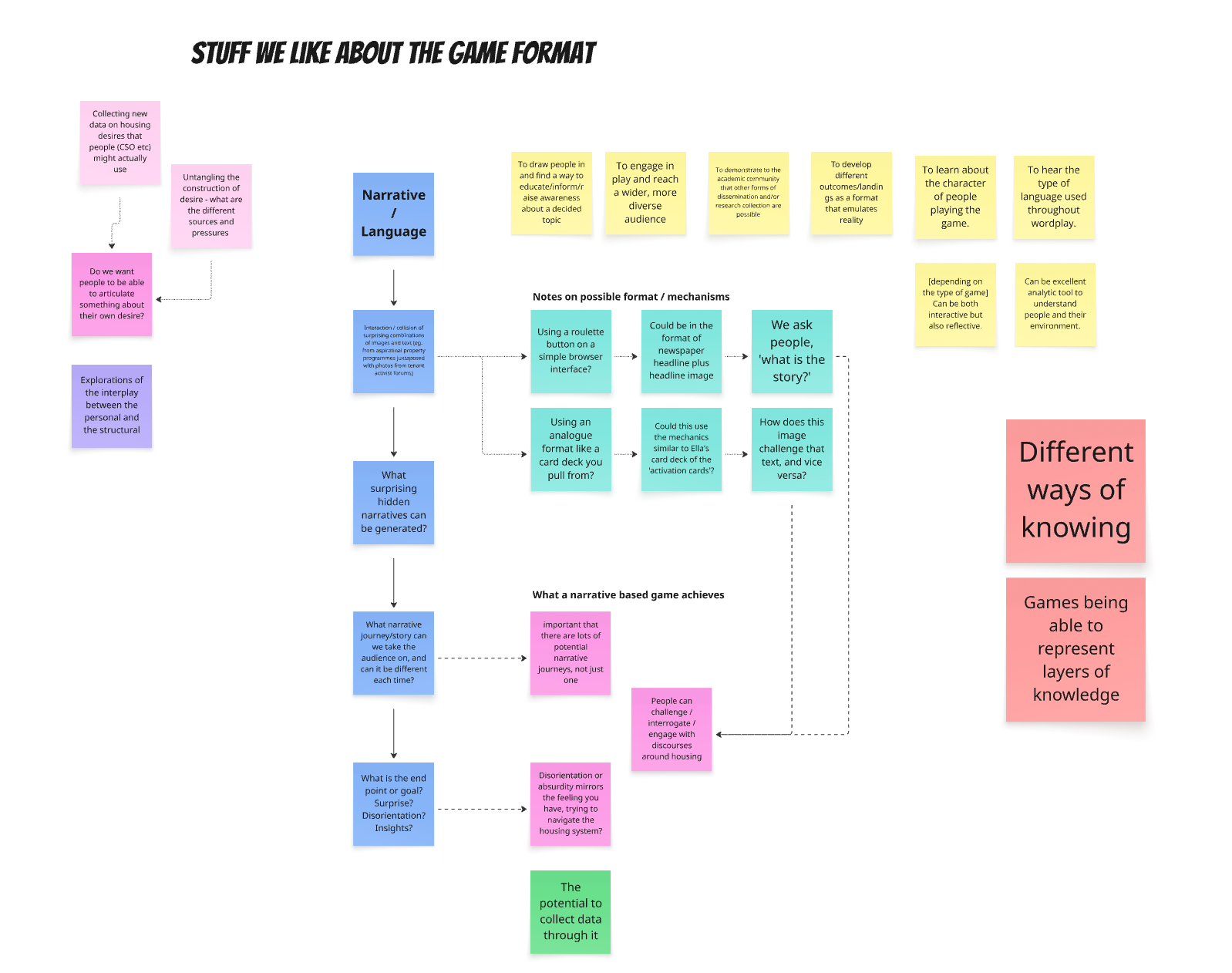This is the research question guiding the research creation process in Oliver Dawkins, Ella Harris, Carla Maria Kayanan and Hannah Mumby’s Commodity Narratives case study. Over the past six months, we have held a series of conversations and have used various tools to extract meaning out of our shared interests on the topic and to point to directions of inquiry. Continuously, we return to our research question to both ground us and forge our path: How do commodity narratives influence housing desires and life journeys?

As part of this case study, on 17 June, Oliver Dawkins and Carla Maria Kayanan attended the Tiny House Games Workshop at Oxford Brookes University. Carla’s funding was supported by Maynooth’s Department of Geography through her Research Incentivisation Award, Navigating Ireland’s housing challenges: Lessons from gamers. The interactive workshop, which was hosted by Mel Nowiki, Ella Harris and Hannah Mumby, was broken down into two parts. The first half provided an opportunity for attendees to learn about, play and provide feedback on Mel and Ella’s Tiny House board game.
Video credit: Kieno Anderson
The board game was created as part of a BA/Leverhulme Small grant funded investigation into Tiny Housing in Texas led by Drs Mel Nowicki, Ella Harris and Tim White. It came about when Ella was tasked with creating a diagram for the forthcoming book Reconstructing the American Dream (Intellect Books, 2025). The diagram was meant to illustrate pathways to tiny housing -e.g. the personal and structural choices and events through which people end up ‘going tiny.’ Drawing a static diagram about something with so many complex variables proved challenging, but as Ella worked through it, she realised her sketches had started to look like the board of a game and the team decided to try out game creation as a way of understanding and articulating these multidimensional pathways. The game creation process became a form of data analysis through which the team identified archetypal tiny house dwellers, typifying characteristics of different typologies of tiny housing, themes in life events that lead to tiny living, etc. At the workshop, we tested a beta version of the game that will now be refined to create a creative output that showcases elements of this research.
The second half of the workshop was focused on experiencing and exploring various forms of game play. Hannah guided the group on an absurd 2.5hr journey that used a variety of different game mechanisms to help participants playfully explore questions about what it means to be human in the modern world, including: the kind of advantages or disadvantages that come from our start in life and how this affects our ability to make choices; how we define success; and how our life journeys relate to social issues around culture and housing. Broadly this whole experience was also an invitation to reflect on how games might be useful in bringing research to life, and making it interactive and engaging for new audiences. The experience involved the following gamified mechanics:
- Identity construction: Participants began by making an identity card, where they drew a head and shoulders picture of a character that they wanted to embody for the duration of the workshop and gave them a name. This then went into a plastic wallet with a string so that participants could wear this around their neck like an identity card.
- Character attributes/stats: Participants turned over their identity card to see a scoring table on the back. They rolled a die to determine their starting score in the areas of wealth, health, bougieness and financial literacy, and wrote their starting score in the boxes, before collecting coloured plastic tokens for each category according to their score.
- Point scoring / narrative arc: based on their starting score, participants then had access to different cards that represented their ‘formative life choices’ – they could choose one card from a pile and turn it over to see what life choice they had made, and the impact this had on their bank of tokens. E.g. “You wait on a council house waiting list indefinitely: GAIN 1 FINANCIAL LITERACY token, LOSE 1 HEALTH token, LOSE 1 BOUGIENESS token”.
- Wheel of fortune: next, participants came up to the front of the room and spun a wheel of fortune which had 4 colour options that it could land on (red, yellow, green or blue). The colour that the wheel landed on for each person determined which society they would move into for the remainder of the game, in small groups.
- Storytelling: in each corner of the room there was a red/yellow/green/blue flag with three symbols of it – participants gathered in their society groups based on the colour they had landed on with the wheel of fortune, and discussed what the symbols on their society flag represented, assigning a word to each symbol. They then were instructed to ask ChatGPT to write them a mission statement for their society based on those three symbols, and they wrote this mission statement on their flag. The entire group went around to visit each society and asked them questions about what their core beliefs and values were, and each small group got into an imaginative mindset telling the story of their society and the role they each played within it.
- Innovation/ideation/problem solving: after a coffee break, participants were confronted with the surprise announcement of a pandemic, and each society was given a different ‘pandemic problem’ that they were tasked with solving as a group through quickfire design and ideation activities (using a ‘Crazy 8s’ activity). Hannah then awarded and deducted points for each society team’s solutions, based on the categories of wealth, health, bougieness and financial literacy.
- Narrative conclusion: Participants then were informed that the pandemic restrictions had been lifted and they could visit other societies, and each person was tasked with meeting another participant from a different society and recounting the story of ‘how I got where I am today’, as a way of reviewing their character’s start in life, their ‘formative decisions’, the beliefs of the society where they lived, the scientific innovations they produced, and in summary, how this made them ‘who they are today’.
- Final scores: At the end, participants counted up the different tokens they had collected throughout the activities, and wrote their final scores on their identity cards. We then had a discussion about the experience and any reflections that it provoked.
Overall, the workshop provided a way of examining how games mechanics can be applied to different topics as an interactive way of bringing themes and issues to life. It also acted as a demonstration of the way creative methods can be brought into dialogue with conventional forms of research. The question of how to use creative methods within research is at the core of Hannah and Ella’s practice as artists and creative researchers, and this workshop was an important opportunity for Carla and Olly to learn more about Ella and Hannah’s arts-based practices and learn-by-doing. As a team we were then able to move deeper into conversations about using games mechanics to help enhance engagement with questions of commodification and desire in relation to housing data, within the Data Stories project.

Recently, the Data Stories team conducted a reading group on the theme of financialisation, a theme that closely intersects with how narratives around housing as an asset influence the handling and presentation of housing data in social housing. One article we read was Ioannue and Wójcik’s (2018) article, On financialisation and its future. In the article, the authors discuss the Financialisation, Economy, Society and Sustainable Development project (FESSUD), one of the largest projects on financialisation, which brings together scholars from various disciplines to theorise financialisation. On the need for interdisciplinary research, the authors write:
“To be sure, such research is never a straightforward exercise, as there are a number of challenges involved, such as the question of which discipline forms the basis and which is invited to add insights (the sequence matters), as well as the risk of compromising disciplinary knowledge.”
At the conclusion of the FESSUD project, the authors agreed that seeking a unified theory of financialisation proved challenging in part because of people’s unwillingness to move beyond their methodological ‘comfort zones.’ While the authors were referencing difficulties in bridging quantitative versus qualitative approaches to realising a unified theory, the sentiment applies to the different methodological and epistemological approaches Ella, Hannah, Olly and Carla bring to the Commodity Narratives case study. In other words, whose methodology will be the foundational methodology that serves as a spring board for other methodologies? Whose methodology is getting compromised, if at all?
We do not yet have any answers. Research creation asks us to embrace this messy process. As such, the ongoing reflection between traditional academic research and arts-based research is indeed fruitful, even if at times confusing. Echoing the work of Natalie Loveless and Sarah Truman, to exist with the space and process of research creation necessitates levels of vulnerability and negating attempts to flee. It eludes a pragmatic application and blurs a clear line between start and finish. On Commodity Narratives, we continue to remain in this nebulous space, but it is one of both excitement and nervous anticipation. Stay tuned to see where we land.